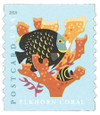
# 5369 - 2019 35c Coral Reefs: Elkhorn Coral (coil)
US #5369
2019 Elkhorn Coral – Coral Reefs (Coil Stamp)
• One of four stamp designs picturing different species of coral and aquatic animals that call reefs home
Stamp Category: Definitive
Set: Coral Reefs
Value: 35¢ Postcard Rate
First Day of Issue: March 29, 2019
First Day City: St. Louis, Missouri
Quantity Issued: 600,000,000
Printed by: Ashton Potter (USA) Ltd.
Printing Method: Offset, Microprint
Format: Coils of 100
Tagging: Nonphosphored Type III, Block Tag
Why the stamp was issued: To cover the postcard rate and celebrate the beauty and diversity of coral reefs.
About the stamp designs: Pictures stylized artwork by Tyler Lang of two French angelfish with elkhorn coral.
First Day City: First Day of Issue Ceremony held at the St. Louis Stamp Expo (March 29-31) in St. Louis, Missouri.
About the Coral Reefs set: Four stamps picturing stylized artwork by Tyler Lang of assorted fish with elkhorn, brain, staghorn, and pillar coral. Raises awareness for the plight of coral reef ecosystems across the globe due to climate change and human disturbances.
History the stamp represents: Found in the clear shallow waters of the Caribbean, elkhorn coral form fast-growing colonies that are home to a variety of marine life.
As its name suggests, elkhorn coral resembles elk antlers, with a structure of several complex branches. It grows quickly – up to five inches per year, reaching 12 feet in diameter and six feet tall. Its yellow or brownish color comes from the zooxanthellae algae that lives inside its tissues. This algae uses photosynthesis to supply the coral with nutrients. Elkhorn also feed on plankton it captures in its tentacles. In turn, elkhorn coral are home to a variety of creatures including lobsters, parrotfish, and shrimp.
Elkhorn coral has been declared an endangered species. It was once plentiful, but an outbreak of white band disease in the 1980s reduced the population by 97 percent. Several other threats have hurt the elkhorn population, including coral bleaching (loss of the algae in its tissue), climate change, and storm damage. This affects not only the coral, but the creatures that depend on it to survive.
Attempts have been made to help recover the elkhorn coral’s numbers, with some success. One advantage they have is that broken antlers can attach themselves to the ground to form new colonies, helping the elkhorn to slowly recover on its own.
US #5369
2019 Elkhorn Coral – Coral Reefs (Coil Stamp)
• One of four stamp designs picturing different species of coral and aquatic animals that call reefs home
Stamp Category: Definitive
Set: Coral Reefs
Value: 35¢ Postcard Rate
First Day of Issue: March 29, 2019
First Day City: St. Louis, Missouri
Quantity Issued: 600,000,000
Printed by: Ashton Potter (USA) Ltd.
Printing Method: Offset, Microprint
Format: Coils of 100
Tagging: Nonphosphored Type III, Block Tag
Why the stamp was issued: To cover the postcard rate and celebrate the beauty and diversity of coral reefs.
About the stamp designs: Pictures stylized artwork by Tyler Lang of two French angelfish with elkhorn coral.
First Day City: First Day of Issue Ceremony held at the St. Louis Stamp Expo (March 29-31) in St. Louis, Missouri.
About the Coral Reefs set: Four stamps picturing stylized artwork by Tyler Lang of assorted fish with elkhorn, brain, staghorn, and pillar coral. Raises awareness for the plight of coral reef ecosystems across the globe due to climate change and human disturbances.
History the stamp represents: Found in the clear shallow waters of the Caribbean, elkhorn coral form fast-growing colonies that are home to a variety of marine life.
As its name suggests, elkhorn coral resembles elk antlers, with a structure of several complex branches. It grows quickly – up to five inches per year, reaching 12 feet in diameter and six feet tall. Its yellow or brownish color comes from the zooxanthellae algae that lives inside its tissues. This algae uses photosynthesis to supply the coral with nutrients. Elkhorn also feed on plankton it captures in its tentacles. In turn, elkhorn coral are home to a variety of creatures including lobsters, parrotfish, and shrimp.
Elkhorn coral has been declared an endangered species. It was once plentiful, but an outbreak of white band disease in the 1980s reduced the population by 97 percent. Several other threats have hurt the elkhorn population, including coral bleaching (loss of the algae in its tissue), climate change, and storm damage. This affects not only the coral, but the creatures that depend on it to survive.
Attempts have been made to help recover the elkhorn coral’s numbers, with some success. One advantage they have is that broken antlers can attach themselves to the ground to form new colonies, helping the elkhorn to slowly recover on its own.









